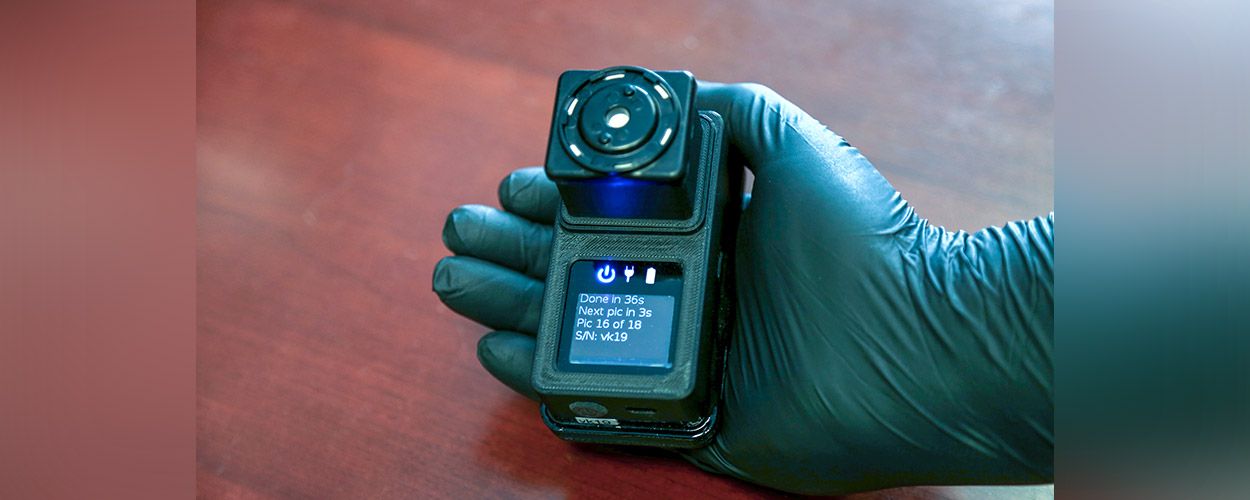Prototype Chemical Identifier Gets Positive Feedback
Prototype Chemical Identifier Gets Positive Feedback
Provided by CCDC Chemical Biological Center Public Affairs Office
A field-deployable liquid chemical identifier called the VK3 received positive feedback from warfighters and first responders in a field test funded by the Defense Threat Reduction Agency (DTRA).
During the Chemical Biological Operational Analysis (CBOA), the VK3 demonstrated its ability to identify chemical liquids in the field, including chemical warfare agent.
This prototype could develop into a new, portable tool that could improve a warfighter’s ability to identify agent.
Developed by scientists and engineers across multiple branches at the U.S. Army Combat Capabilities Development Command (CCDC) Chemical Biological Center, VK3 is a portable, handheld tool that uses a camera and small computer to identify chemical agent by analyzing colorimetric sensors on an assay.
The need for the technology came from a desire to ensure warfighters examining labs and substances in the field had a portable, easy-to-use tool to identify chemical threats.
“We had seen and heard that those who are tasked with sensitive site exploitation — the first people in a facility where somebody is making something – needed tools to better identify the substances being made,” said Center research biologist Aleksandr Miklos, Ph.D. “Maybe it’s perfectly legal and safe, but maybe they’re doing something illicit and dangerous.The first examiner has to decide what tools to bring. We thought something like this with a colorimetric assay would be helpful.”
To use, the operator places a colorimetric assay on the device’s stage for a reference image, a drop is added to the assay. As various spots on the assay change color, they are captured by the camera and continuously analyzed by the computer to identify the substance.
An earlier version, called the VOCKit, identified chemicals based on vapors, a process similar to olfaction — the sense of smell. Now, Miklos says that taste, not smell, is a better analogy.
“This started off as something that detected vapors coming off of the sample. It was very similar to how the olfactory system works,” Miklos said, noting that the device had many spots that would activate in response to vapor from a sample. “By the pattern of activation, they could identify what was present. Now, we’re using a ticket you add liquid to.”
Users at the CBOA found the device easy to use.
One thing users appreciated was the clarity in use. The device delivers clear on-screen instructions with a timer.
“What we were able to get was informal, verbal feedback from the assessor and from end users in the Army and civilian law enforcement,” Miklos said. “Feedback was positive. They liked the size and that they could carry the entire kit around in a small container.”
One thing users appreciated, according to Miklos, was the clarity in use. The device delivers clear on-screen instructions with a timer. “As soon as the system initializes, the device flashes the lights, and once it’s ready, it will take pictures of the ticket,” Miklos said.
The VK3 differs from other detectors, like the Joint Chemical Agent Detector (JCAD).
“The JCAD is a continuous monitor of vapor, while this would be for explicitly looking at a puddle or a container of something,” Miklos explained. “VK3 is also smaller, cheaper, and requires less power than the JCAD.”
Moving the VK3 forward entails additional testing and expansion of its library database. While it can currently identify multiple liquid chemicals relevant to the military, it must be trained on those chemicals to identify them successfully. Because of this, Miklos said different variants of the VK3 could be trained on different chemicals, as law enforcement users might have different needs from military users.
“It identifies what we train it against,” Miklos explained. “It’s still a research prototype, so we’ve trained it against a somewhat small list of things, about 50. The list is a mixture of chemical warfare agents, as well as some common stuff like bleach, diesel, and insecticides.”
To get precise readings, the VK3 is trained on different variants of the same substance.
“We need to develop a better database to account for variability in chemicals,” Miklos said. He offered bleach as a specific example, “I would want 100 bleach samples — fresh bleach, slightly old bleach, bleach that came from Europe, scented bleach. Bleach is not just bleach. We need to make sure we sampled bleach so well, that there’s no room for error in detection.”
On the battlefield, that variability could yield clues about whether chemical threats were “made by professionals, or in a pail in the back of a pickup truck,” Miklos said.
“It’s a really cool research prototype, and now we know more about how it works,” Miklos said. “The question is going to be whether it gets more funding for advanced development. What we need is for someone to say, “Yes, we want it.”
The VK3 is a prototype chemical identifier that can identify liquids in the field, including chemical warfare agent.

